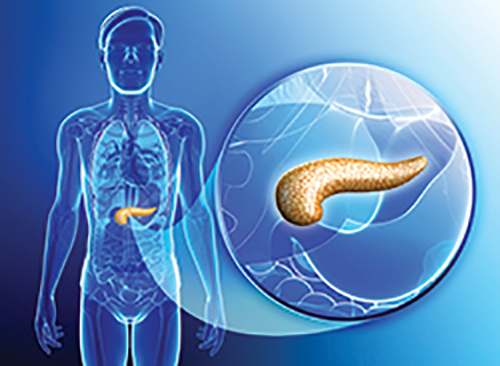An international team of researchers led by Max Delbrück Center Scientific Director Professor Maike Sander, MD, has for the first time developed an organoid model of human pluripotent stem cell-derived pancreatic islets (SC-islets) with integrated vasculature.
Researchers in the Sander lab at the University of California, San Diego, found that SC-islet organoids with blood vessels contained greater numbers of mature β cells and secreted more insulin than their non-vascularized counterparts. The vascularized organoids more closely mimicked islet cells found in the body.
The development could help improve diabetes research and cell-based therapies. “Our results highlight the importance of a vascular network in supporting pancreatic islet cell function,” said Sander. “This model brings us closer to replicating the natural environment of the pancreas, which is essential for studying diabetes and developing new treatments.”
Sander and colleagues reported on their studies in Developmental Cell, in a paper titled, “Engineered vasculature induces functional maturation of pluripotent stem cell-derived islet organoids.” In their report, they concluded, “Vascularized SC-islets will enable further studies of crosstalk between β cells and ECs and will serve as an in vitro platform for disease modeling and therapeutic testing.”
Islets are cell clusters in the pancreas that house several different types of hormone-secreting cells, including insulin (INS)-producing β cells. SC-islet cell organoids—mini-organs that mirror the insulin-producing cell clusters outside the body—are widely used to study diabetes and other pancreatic endocrine diseases. But β cells in these organoids are typically immature, making them suboptimal models for the in vivo environment, said Sander, noting that while several approaches have been developed to promote β cell maturation, their effects have been modest. The authors further commented in their paper that “SC-β cells acquire a more mature state after in vivo engraftment, implying that the ex vivo culture model lacks important environmental cues for β cell maturation.”
Current SC-islet models lack nonendocrine cell types found in the native tissue environment. The team, in addition, pointed out that while vasculature is crucial for islet function, “… no in vitro model currently replicates the 3D vascular network of the native islet niche.”
To better mimic the in vivo environment, the researchers added human endothelial cells (ECs), which line blood vessels, and fibroblasts, cells that help form connective tissue, to islet organoids grown from stem cells. The team experimented with different cell culture media—“ECs and SC-islets each require a specific culture medium for optimal cell viability,” they pointed out—until they found a cocktail that worked. In these models, the cells not only survived, but they also matured and grew a network of tube-like blood vessels that engulfed and penetrated the SC-islets.
“Our breakthrough was devising the recipe,” Sander said. “It took five years of experimenting with various conditions, involving a dedicated team of stem cell biologists and bioengineers.”
When the researchers compared vascularized organoids to non-vascularized organoids, they found the former secreted more insulin when exposed to high levels of glucose. “Immature β cells don’t respond well to glucose. This told us that the vascularized model contained more mature cells,” said Sander.
The researchers next wanted to explore how specifically vasculature helps organoids to mature. They found two key mechanisms: Endothelial cells and fibroblasts help build the extracellular matrix, a web of proteins and carbohydrates at cell surfaces. The formation of the matrix itself is a cue that signals cells to mature. Secondly, endothelial cells secrete bone morphogenetic protein (BMP), which in turn stimulates β cells to mature.
![Researchers have devised the right conditions to grow vascularized stem cell islets. The image shows vasculature (red) tightly wrapped around insulin-producing cells (green) in the islets (blue). [Image credit: Sander lab]](https://www.genengnews.com/wp-content/uploads/2025/05/low-res-6-300x261.jpeg)
Recognizing that mechanical forces also stimulate insulin secretion, the team then integrated the organoids into microfluidic devices, allowing nutrient medium to be pumped directly through their vascular networks. They found that the proportion of mature β cells increased even further.
“We found a gradient,” said Sander. “Non-vascularized organoids had the most immature cells, a greater proportion matured with vascularization, and even more matured by adding nutrient flow through blood vessels. A human cell model of pancreatic islets that closely replicates in vivo physiology opens up novel avenues for investigating the underlying mechanisms of diabetes,” she added.
In a final step, the researchers showed that vascularized SC-islets also secrete more insulin in vivo. Diabetic mice grafted with non-vascularized SC-islets fared poorly compared to those grafted with vascularized SC-islet cells, with some mice showing no signs of the disease at 19 weeks post-transplant. “Consistent with the importance of ECs for β cell function, we show that the presence of vasculature improves the response of SC-β cells to physiological stimuli of INS secretion in vitro as well as the functionality of engrafted SC-islets in vivo,” the authors stated. The research supports other studies that have shown that pre-vascularization improves the function of transplanted SC-islets.
Sander plans to use vascularized SC-islet organoid models to study type 1 diabetes, which is caused by immune cells attacking and destroying β cells in the pancreas, in contrast to type 2 in which the pancreas produces less insulin over time and the body’s cells become resistant to the effects of insulin. “The microfluidic SC-islet model with perfused vasculature provides a platform in which effects of diabetes-associated local and systemic environmental conditions can be studied,” the investigators wrote.
Sander and team at the Max Delbrück Center are growing vascularized organoids from the cells of patients with type 1 diabetes. They are transferring the organoids onto microfluidic chips and adding patients’ immune cells. “We want to understand how the immune cells destroy β cells,” Sander explained. “Our approach provides a more realistic model of islet cell function and could help develop better treatments in the future.”
In their report, the team pointed out, “… the vascularized SC-islet organoid will serve as a platform to further engineer the cellular complexity of the pancreatic islet for disease modelling … In the long term, the goal is to develop a fully autologous SC-islet organoid model to study mechanisms of autoimmune β cell destruction in type 1 diabetes.”



